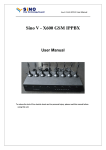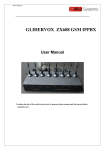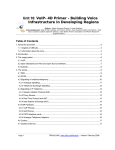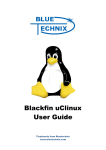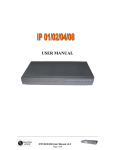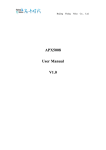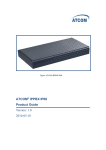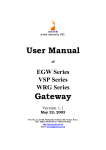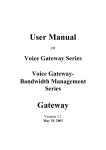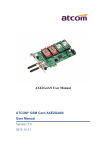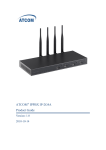Download IP-XX User Manual - Inteligentne Produkty
Transcript
www.atcom.cn IP-XX User Manual 1/ www.atcom.cn 1 Introduce ................................................................................................................................. 4 2 Configure the device via GUI .................................................................................................. 5 2.1 Access the GUI...................................................................................................................... 5 2.2 System Status ....................................................................................................................... 5 2.3 Configure Hardware ............................................................................................................ 6 2.4 Trunks .................................................................................................................................. 6 2.5 Outgoing Calling Rules ........................................................................................................ 7 2.6 Dial Plans.............................................................................................................................. 8 2.7 Users ..................................................................................................................................... 9 2.8 Ring Groups........................................................................................................................ 10 2.9 Music on Hold .................................................................................................................... 11 2.10 Call Queues ......................................................................................................................... 12 2.11 Voice Menu (IVR) ............................................................................................................... 14 2.12 Time Intervals .................................................................................................................... 15 2.13 Incoming Calling Rules ...................................................................................................... 16 2.14 Voicemail ............................................................................................................................ 17 2.15 Conferencing ...................................................................................................................... 19 2.16 Follow Me ........................................................................................................................... 20 2.17 Directory ............................................................................................................................ 21 2.18 Voicemail Group ................................................................................................................. 21 2.19 Voice Menu prompts .......................................................................................................... 21 2.20 BackUp................................................................................................................................ 22 2.21 Active Channels .................................................................................................................. 22 2.22 Advance Options ................................................................................................................ 23 2.23 Advance Options—Network Settings............................................................................... 23 2.24 Advance Options—Call Detail Records ............................................................................ 23 2.25 Advance Options—Firmware Update .............................................................................. 24 2.26 Advance Options—File Editor .......................................................................................... 24 3 Application notes .................................................................................................................. 26 3.1 Install hardware ................................................................................................................. 26 3.2 Different methods to access the IPxx ............................................................................... 27 3.3 Make free internal calls ..................................................................................................... 29 3.4 Make outbound calls to PSTN ........................................................................................... 31 3.4.1 Analog/FXO trunking .................................................................................................... 31 3.4.2 VoIP trunking ................................................................................................................. 33 3.5 Combine the IP04 with exist traditional PBX .................................................................. 35 3.6 Intercommunication between two IPXX .......................................................................... 36 3.6.1 Link two IP04s in the same network............................................................................ 36 3.6.2 Link two IP04s in different location ............................................................................. 39 3.7 Voicemail to Email Configure example ............................................................................. 40 3.8 Call Features ....................................................................................................................... 41 3.8.1 Call Pick Up .................................................................................................................... 41 2/ www.atcom.cn 3.8.2 Call Park ......................................................................................................................... 41 3.9 Cron .................................................................................................................................... 41 3.10 Backup and restore file ..................................................................................................... 41 3.11 Call queue agent Login and Logout .................................................................................. 42 3.12 DISA .................................................................................................................................... 42 4 FAQ ......................................................................................................................................... 43 4.1 What is the user/password of my IP PBX? ...................................................................... 43 4.2 Why there are two kind of firmware available for download? ....................................... 43 4.3 How to upgrade via IP –PBX via RS232 console port? .................................................... 43 4.4 How to change my IP address? ......................................................................................... 45 4.5 What is the OS and asterisk version used in IP-PBX? ..................................................... 46 4.6 How to customs my firmware for IP-PBX?....................................................................... 46 3/ www.atcom.cn 1 Introduce This Article This article is the user manual for the IP-XX series products. It also includes the application notes for how to use ATCOM products to build a telephony system for small office. Through this article, we hope that users can build the IP telephony system via IP-XX series products. The IP-XX series PBXs include IP01, IP02, IP04, IP08 and IPBRI so far, since they have almost the same software and structure so we will use IP04 as the demo unit on this article. Same method is available to the IP-XX series products. IP01, IP02 ,IP04, IP08 & IP-BRI The IP-XX series PBXs are open source embedded IP PBX systems. They run uClinux and Asterisk and support rich IP PBX features. They have big advantages on its inherent open source software structure and ultra low power consumption ( <5 watt in idle state, environment friendly). Below are the difference between the IP01, IP04 and IP08 platform. Model No. RJ45 TEL Ports RS232 Port Others Size(mm) IP-01 1 1 x fxo/fxs 1 fix RS232 port -- 100 x 100 x 28 IP02 2 2 x fxo/fxs 1 RS232 module -- 100 x 100 x 28 IP-04 1 4 x fxo/fxs 1 RS232 module MMC 225 x 120 x 30 IP-08 2 8 x fxo/fxs 1 RS232 module MMC,USB 225 x 120 x 30 IP-BRI 1 4 x BRI TE 1 fix RS232 port MMC 225 x 120 x 30 4/ www.atcom.cn 2 Configure the device via GUI 2.1 Access the GUI The IP04 GUI is immigrated from Asterisk Now 2.0 version. The default IP for IP04 is 192.168.1.100. Put the default ip in your web browser and it will redirect to the setting page of IP04, the default password for the web access is: Username: admin Password: mysecret If you can’t access the IP04, please check if you have connect the RJ45 cable to the WAN port and your computer is in the same network 192.168.1.xxx as the IP04. Note: the recommend web browser of IP04 is Firefox. 2.2 System Status When you have entered the IP04 setting page, the system status will be showed and you can see the system status as below: 5/ www.atcom.cn 2.3 Configure Hardware The Configure Hardware page lists the available telephony ports in your system. You can configure the hardware to comply with your local telephony environment. Note: Hover on the (i) and you can see the comment of every settings. 2.4 Trunks Trunks are used to make outbound call to the real world. There are different trunks we can set here. We have put the IP04 with four FXO ports so there are four analog trunks in this setting page. VoIP trunks (SIP&IAX2) are also available in the IPXX. More info about how to set up the trunks, please refer the application notes. 6/ www.atcom.cn 2.5 Outgoing Calling Rules Outgoing Calling Rules defines the calling permission sand the routing rules when making calls. Calling Rule Name: The name of your calling rule Pattern: Describe what numbers should use this rule: X ... Any Digit from 0-9 Z ... Any Digit from 1-9 N ... Any Digit from 2-9 [12345-9] ... Any Digit in the brackets (in this example, 1,2,3,4,5,6,7,8,9 . ... Wildcard, matches anything remaining; i.e. _9011. Matches anything starting with 9011 (excluding 9011 itself) ! ... Wildcard, causes the matching process to complete as soon as it can unambiguously determine that no other matches are possible For example, the extension _NXXXXXX would match normal 7 digit numbers, while _1NXXNXXXXX would represent a three digit area code plus phone number, proceeded by a one. Use/Trunk: Describe which trunk should be used in this rule Strip: Define how many digits should be removed from the dialstring. Two samples for calling rule setting: 1) Cut the first digit for all dialstring start with 9, and make outgoing call via port1: Calling Rule Name: Out_9 Pattern: _9. Use/Trunk: Ports 1 Strip: 1 digits from the front In this case, if you dial 983018806 in your extension, 83018806 will be sent via port1 2) Cut the first digit for all dialstring start with 0, and prepend 86 then dial via voipbuster trunk. 7/ www.atcom.cn Calling Rule Name: Out_voipbuster Pattern: _0. Use/Trunk: Voipbuster Strip: 1 digits from the front And prepend these digits 86 In this case, if you dial 075583018806 in your extension, 8675583018806 will be sent via voipbuster trunk 2.6 Dial Plans A Dial Plan is a collection of Outgoing Call Rules. Dial Plans are assigned to Users to specify the dialing permissions they have. For example, you might have one Dial Plan for local calling that only permits users of that Dial Plan to dial local numbers, via the "local" outgoing calling rule. Another user may be permitted to dial long distance numbers, and so would have a Dial Plan that includes both the "local" and "longdistance" outgoing calling rules. 8/ www.atcom.cn 2.7 Users This page allow administrator to create extensions for every user. General: Extension: The number you can dial to reach this user. Name: CallerID name of the user. CallerID: The CID string when you dial to other internal users. Outbound CallerID: Specify the public CallerID for outbound calls, it is only available when your digital or voip provider support this feature. VoiceMail: Voicemail Access PIN code: The password of your voicemail box Email address: The email address for the voicemail to email function. Technology: SIP: enable this option so the extension can be a SIP device. IAX2: enable this option so the extension can be an IAX2 device. Analog Station: If you have analog FXS ports in your IP04, you can select the port here for your extension. flash/rxflash: flash parameter for the users. Codec preference: specify the preference codec for the users. Voip Setting: MAC address: used for polycom phone provisioning. Line Number: used for polycom phone provisioning. Linekeys: used for polycom phone provisioning. SIP/IAX2 password: user password for SIP/IAX2 registration. NAT: enable this when you use the IP04 in public network and the sip devices are in 9/ www.atcom.cn private network. Can Reinvite: enable this and the IP04 will try to negotiate the endpoints to route the media string directly (not through IP04). This can reduce the CPU load of the IP04 and you will get better voice performance because the media string are sent directly from endpoint to endpoint. DTMF mode: DTMF uses on conversation, the RFC2833 is the most common. Insecure: method of authentication, Other Options: 3-Way Calling: enable/disable 3-way calling In directory: check this if the user is listed in the directory. Call waiting: enable/disable Call waiting CTI: Computer Telephony Integration, allows access to 3rd party applications over Asterisk Manager Interface. Is Agent: check this if the user is available in call queue. Pick up Group: Specify the call pick up group. Call Group: Specify the call group for the user. 2.8 Ring Groups Define the Ringroups to dial more than one extension simultaneously, or to ring more than one phone sequentially. 10/ www.atcom.cn 2.9 Music on Hold Customize audio tracks for different queues, parked calls etc. 11/ www.atcom.cn 2.10 Call Queues Call queues allow calls to be sequenced to one or more agents. Extension: This option defines the numbered extension that may be dialed to reach this Queue. Name: This option defines a name for this Queue, i.e. "Sales". 'Name' is a label to help you see this queue in the queue list. Strategy: This option sets the Ringing Strategy for this Queue. The options are RingAll: Ring All available Agents simultaneously until one answers. RoundRobin: Take turns ringing each available Agent. LeastRecent: Ring the Agent which was least recently called FewestCalls: Ring the Agent with the fewest completed calls. Random: Ring a Random Agent. RRmemory: RoundRobin with Memory, Remembers where it left off in the last ring pass. Agents: This selection shows all Users defined as Agents in their User conf. Checking a User here makes them a member of the current Queue. Music On Hold: Select the 'Music on Hold' Class for this Queue. 'Music on Hold' classes can be managed from the 'Music On Hold' panel. LeaveWhenEmpty: This option controls whether callers already on hold are forced out of a queue that has no agents. There are three options. Yes: Callers are forced out of a queue when no agents are logged in. No: Callers will remain in a queue with no agents. Strict: Callers are forced out of a queue with no agents logged in, or if all logged in agents are unavailable. Join Empty:This option controls whether callers can join a call queue that has no agents. There are three options, Yes: Callers can join a call queue with no agents or only unavailable agents No: Callers cannot join a queue with no agents Strict: Callers cannot join a queue with no agents or if all agents are unavailable. Queue Options: 12/ www.atcom.cn Timeout: How many seconds an Agent's phone will ring before the Queue tries to ring the next Agent. Wrapup Time: How many seconds after the completion of a call an Agent will have before the Queue can ring them with a new call. The default is 0, which is no delay. MaxLen: How many calls can be queued at once. This count does not include calls that have been connected with Agents, it only includes calls that have not yet been connected. Default is 0, which is no limit. When the limit has been reached, a caller will hear a busy tone and advance to the next calling rule after attempting to enter the queue. AutoFill: Defining this option causes the Queue, when multiple calls are in it at the same time, to push them to Agents simultaneously. Thus, instead of completing one call to an Agent at a time, the Queue will complete as many calls simultaneously to the available Agents. AutoPause: Enabling this option pauses an agent if they fail to answer a call. This means that the agent is still logged into the queue, but they will not receive calls from the queue. Once paused, an agent can unpause by logging into the queue using the regular agent login extension. Report Hold Time: Enabling this option causes Asterisk to report, to the Agent, the hold time of the caller before the caller is connected to the Agent. KeyPress Events: If a caller presses a key while waiting in the queue, this setting selects which voice menu should process the key press. Agent Login Extension: Extension to be dialed for the Agents to Login to the Specific Queue. This is an extension that all the Agents can Call to Login to their specified Queues. Agent Callback Login Extension: Extension to be dialed for the Agents to Login to the Queues they are apart of. Same as Agent Login Extension, except you do not have to remain on the line. 13/ www.atcom.cn 2.11 Voice Menu (IVR) Menus allow for more efficient routing of calls from incoming callers. Also known as IVR (Interactive Voice Response) menus or Digital Receptionist. Name: Name of this Voice Menu Extension: If you want this Voicemenu to be accessible by dialing an extension, then enter that extension number. Dial other Extensions: Is the caller allowed to dial extensions other than the ones explicitly defined. Actions: A sequence of actions performed when a call enters the menu. Add a new step: Add additional steps performed during the menu. Keypress Events: Allow key press events will cause the system to listen for DTMF input from the caller and define the actions that occur when a user presses the corresponding digit. 14/ www.atcom.cn 2.12 Time Intervals Time Intervals are defined ranges of time that will be used by call routing features. Name: Name of the time Interval By day of week: Define the day range by week for time interval By days of a month: Define the day range by Month for time interval Time /Entire day: Define if the time interval is available for the whole day or only for the specified hours. 15/ www.atcom.cn 2.13 Incoming Calling Rules Create, modify, prioritize and delete incoming call rules for handling Incoming calls based on service provider and/or the number called based on Time Intervals. Trunk: Which service provide should use this trunk for its incoming calls. Time Interval: ranges of time that will be used in this rule. Pattern: Incoming call pattern. Destination: where should the incoming call is routed. 16/ www.atcom.cn 2.14 Voicemail General settings for voicemail function. General Voicemail Settings: Extension for checking Message: This option, i.e. "2345" defines the extension that Users call in order to access their voicemail accounts. Direct VoiceMail Dial: Check this to enable direct voicemail dial. For instance, if John's extension is 6001, you would be able to directly dial into John's voicemailbox by dialing #6001 to leave him a message. Max Greeting:Set the maximum number of seconds for a User's voicemail greeting. Dail 'O' for Operator: Enable Callers to exit the voicemail application and connect to an operator extension. The operator extension must be defined from the 'Options' panel. Maximum messages per folder: This select box sets the maximum number of messages that a user may have in any of their folders. Maximum Message Time: This select box sets the maximum duration of a voicemail message in seconds. Message recording will not occur for times greater than this amount. Minimum message Time: This select box sets the minimum duration of a voicemail message in seconds. Messages below this threshold will be automatically deleted. Say Message Caller-ID: If this option is enabled, the Caller ID of the party that left the message will be played back before the voicemail message begins playing. Say Message Duration (in minutes): If this option is set, the duration of the message in mintues will be played back before the voicemail message begins playing. Allow callers to Review: Checking this option allows the caller to review their message before it is submitted as a new voicemail message. Play Envelope: Turn on/off playing introductions about each message when accessing them from the voicemail application. 17/ www.atcom.cn Voicemail to Email: with this function configured, when there is a new voicemail for users, the ip04 will automatically send the voicemail to the user’s email address set in the user’s profile. Voicemail to Email Preference: Send messages by e-mail only: If this option is set, then voicemails will not be checkable using a Phone. Messages will be sent via e-mail, only. Note: You need to have an smtp server configured for this functionality. Attach recording to e-mail: This option defines whether or not voicemails are sent to the Users' e-mail addresses as attachments. Note: You need to have an smtp server configured for this functionality. SMTP server setting SMTP Server: The IP address or hostname of an SMTP server that your Astfin box may connect to, without authentication, in order to send e-mail notifications of your voicemails; i.e. mail.yourcompany.com Port: The port number on which the SMTP server is running; generally port 25. Note: for Setup example for the Voicemail to Email please refer the application note. 18/ www.atcom.cn 2.15 Conferencing MeetMe conference bridging allows quick, ad-hoc conferences with or without security. Extension: This is the number dialed to reach this Conference Bridge. Marked/Admin user Extension: If the conference bridge is to have marked users or admin users, then those users should enter the conference bridge using a separate extension. Admin conference users can lock and unlock the conference and can kick the most recent conference participant. Marked users are special users whose entrance and exit, if the Wait for Marked user or Close conference when last marked user exits can either begin or end the conference altogether. Pin Code: set an optional pin code, Ex: "1234" that must be entered in order to access the Conference Bridge. Administrator PIN Code: Defining this option sets a PIN for Conference Administrators. Play Hold Music for First Caller: Checking this option causes Asterisk to play Hold Music to the first user in a conference, until another user has joined the same conference. Enable Caller Menu: Checking this option allows a user to access the Conference Bridge menu by pressing the * "Asterisk" key on their dialpad. Announce Callers: Checking this option announces, to all Bridge participants, the joining of any other participants. Quiet Mode: Do not play enter/leave sounds Wait for Marked User: Prevent conference participants from hearing each other until the marked user has joined. 19/ www.atcom.cn 2.16 Follow Me Status: Enable/Disable FollowMe for this user. Music On Hold class: that the caller would hear while tracking the user. DialPlan: DialPlan that would be used for dialing the FollowMe numbers. By default this would be the same dialplan as that of the user."; Destinations: List of extensions/numbers that would be dialed to reach the user during FollowMe. 20/ www.atcom.cn 2.17 Directory Preferences for 'Dialing by Name Directory' Directory Extension: Extension to dial for accessing the Name Directory Read Extension number: In addition to the name, also read the extension number to the caller before presenting dialing options Use first Name instead of Last Name: Allow the caller to enter the first name of a user in the directory instead of using the last name 2.18 Voicemail Group Define 'VoiceMail Groups' to leave a voicemail message for a group of users by dialing an extension. 2.19 Voice Menu prompts Record or Upload custom VoiceMenu prompts. 21/ www.atcom.cn 2.20 BackUp Backup or Restore the configure files. Note: Restored the backup won’t take effect on the network setting. You need to modify the network setting in the GUI and save/reboot. 2.21 Active Channels Displays current Active Channels on the PBX, with the options to Hangup or Transfer. 22/ www.atcom.cn 2.22 Advance Options In the Options Panel, choose Advanced Options--> show Advanced Options then the advanced options will be showed in the left menu. The advances options include: Call Detail Records Active Channels Bulk Add File Editor Asterisk CLI IAX Settings SIP Settings Network Settings Firmware update 2.23 Advance Options—Network Settings Network and time zone settings. Note: you need to reboot the device to make the ip and timezone take effect. 2.24 Advance Options—Call Detail Records Shows the call details. 23/ www.atcom.cn 2.25 Advance Options—Firmware Update Update the firmware of your device HTTP and TFTP update is available for the firmware update. TFTP server: TFTP server which include the update firmware File Name: name of the new firmware, please make sure that you are using a md5 firmware for the updating. Reset Configs: enable this if you want to reset the networking and asterisk configs after upgrade. 2.26 Advance Options—File Editor Here you can modify the asterisk configure files directly. 24/ www.atcom.cn Note: Please make sure you know what the meaning in the files before trying to modify these files. 25/ www.atcom.cn 3 Application notes 3.1 Install hardware The IPXX series IP PBXs use interchangeable FXO/FXS modules. The FXO and FXS signaling use different modules. Below are the available modules for the system. FXO: use to connect to the PSTN line FXS: use to connect to the analog phone. Install illustration: 1) IP01 with one FXO 2) IP04 with two fxo two fxs modules. 26/ www.atcom.cn 3.2 Different methods to access the IPxx There are several ways to access the IPXX series products. Different ways has different usage. The web/SSH/telnet accesses are base on network connection, and the console port access is via the console cable which allows you to access the devices on a lower level. Web access It is the most common way to access the IPxx. Most settings can be done through the web interface. Simply put the device’s IP address in your web browser (better use Firefox) and enter the username and password to access the device. The web access username/password is admin/mysecret SSH access This is the advance way to access the device, you can use the putty software to access the device. in the ssh access, you can access the Linux directly and do more advance linux setting and debug. The SSH user/password is root/uClinux Telnet access The telnet access is similar with the SSH access but it is not suggested because it is not as convenient as SSH access. Console access The console access is used mainly for develope purpose or in the case when network is down. Below are the connections pictures for console access For IP01 & IP02 For IP04 Below is the console port setting to access the IPXX Running the Hyper Terminal or Minicom in your computer to connect the IP04, the setting of the console port should be: 27/ www.atcom.cn Bits per second to 115200; Data bits : 8 Parity: None Stop bits: 1 Flow control: None 28/ www.atcom.cn 3.3 Make free internal calls Making internal calls are the base requirement for a telephony system. Below are the settings for this usage. It is base on IP04 but setting is the same in other IPXX products. System Setup At the beginning, we need to add some extensions to make internal calls. Each extension acts as an internal number. There are three types of extensions we can add: SIP, IAX2 and ZAP. Before set up the extensions, we need to go to the Options --> General Preferences to set the user extensions range. The default user extensions range is from 6000~6299. The extension 6000 is used for auto-attendant so don't register on this extension. Then go to page Dial Plan-->Create New Dialplan to create a default Dial Plan. 29/ www.atcom.cn Then go to page Users-->Create New User to create the extensions: 6001 Use the same method to add the extensions: 6002, 6003 and 6004. In our system picture, we use softphone x-lite to register on 6001 and 6002. Use AT-530 IP phone to register on the extensions 6003 and 6004. Then these four extensions can communicate with each other use the numbers 6001, 6002, 6003 and 6004. 30/ www.atcom.cn 3.4 Make outbound calls to PSTN There are many kinds of trunking you can use to make outgoing calls. It includes: Analog FXO trunk, Digital E1/T1/BRI Trunk, SIP trunk, IAX trunk etc. 3.4.1 Analog/FXO trunking For the IP01/04/08, you can install FXO module and use the FXO trunking to make outgoing call via your local PSTN line. The set up is as per below: Step 1: Create FXO trunk Go to page Trunks--> Add New Analog Trunk Note: The port1 and port2 of IP04 are slotted with FXO modules. Always click "Apply Changes" in the right top corner when you do some changes. Step 2: Create Outgoing Calling Rules 31/ www.atcom.cn Go to page Outgoing Calling Rules. The pattern _9. and strip 1 digits means all calls start with 9 will be cut the first digit and sent out via this rule. for example, if you dial 983018049, the ip04 will send 83018049 to port1 or port2. Step 3: Add New DialPlan Go to page Dial Plans--> Crear New Dial Plans Set the DialPlan1 to default dial plan so every new extension will use this dialplan in default. Then you can use your extensions to dial out via the port1 and port2. 32/ www.atcom.cn 3.4.2 VoIP trunking Via the voip trunking we can dial call via the voip service to reduce our cost when making international calls. Step 1: Add Voip trunks Go to page Trunks--> Voip Trunks--> Add New Sip trunks We use the Voipbuster as our voip service provider here. Step 2: Add voip calling rule Go to page Outgoing Calling Rules. 33/ www.atcom.cn All calls start with 00 will be sent out via our voip service provider. Step 3: Add this new calling rule to the dial plan1 All extensions which use dialplan1 are able to use the voipbuster service now 34/ www.atcom.cn 3.5 Combine the IP04 with exist traditional PBX Introduce: Assume that we already have a (3-8 3fxo 8extensions) traditional PABX in our office and we want to add more pstn lines/extensions or use voip solution in the exist solution. We can combine the IP04 with the exist PABX solution use below structure. 1/ Connect the FXO port of the PABX to IP04's FXS port. so the PABX will be one of the IP04's FXS extensions and all the extensions under pabx can use all the fxs functions from IP04, the functions include: make calls to the ip04's other extensions make calls use the ip04 voip trunk make PSTN via ip04's PSTN trunk 2/ Connect the FXS port for the PABX to IP04's FXO port. So the IP04 will be one of the PABX extensions and all the extensions under pabx can use all the fxs functions from pabx, the functions include: make calls to the pabx's other extensions make PSTN via pabx's PSTN trunk 35/ www.atcom.cn 3.6 Intercommunication between two IPXX Introduce: This application note shows how to link two IP04 in different location. With this function, we can link branches together with IP04. Same method can be used when connect more than 2 IP04 in different branches. 3.6.1 Link two IP04s in the same network The simplest case to link two IPxx together is in the same network. We start from this and then try to expand to different network. We use IP04 here, same method for other IPXXs products. Below is the structure of how to link two IP04s in the same LAN: The method of connecting two IP04s in different location is: 1) register the IP04A as an extension in IP04B(via IAX2 trunk) so the extensions in IP04A can make calls to IP04B’s extensions via this “special” trunk. 2) use the reverse method in IP04B to register to IP04A. In above structure: 1) AT-530A registers to IP04A as an extension 6001. 2) AT-530B registers to IP04B as an extension 5001. 3) All the extensions under IP04A are in the format 6XXX. 4) All the extensions under IP04B are in the format 5XXX 5) Extensions under IP04A can make calls to extension under IP04B use format 5XXX. 6) Extensions under IP04B can make calls to extension under IP04A use format 6XXX. 7) The two IP04 links each other via IAX2 trunk. Step 1: Set up a extension 6005 in IP04A Extension: 6005 ; Phone number of this extension Name: User_IP04B ; Password: 6005 ;IAX2 Log on password Caller ID: 6005 ; Caller ID 36/ www.atcom.cn Step 2: Set up an IAX trunk in IP04B to link to IP04A via this User_IP04B extension. In the page Trunks--> Add Voip Trunk Step 3: Set Calling Rule in IP04B, all calls start with 6 will be sent to IP04A. In the page: Outgoing Calling Rules--> Add New Calling Rule Step 4: Add this new calling rule "Out_IP04A" to the exist dial plan. In the page: DialPlan --> Edit DialPlan1 Active the change and apply the test: 37/ www.atcom.cn 1/Register an IP phone AT-530B to IP04B with 5001 extension. 2/Register an IP phone AT-530A to IP04A with 6001 extension. 3/Use 5001 to dial 6001. And you can see 6001 is ringing and you can pick up the calls. Above is the way to router IP04B’s call to IP04A, the method to link IP04A to IP04B is the same as above. 38/ www.atcom.cn 3.6.2 Link two IP04s in different location The generally environment for two ip04 in different location is: two IP04 are both behind router and using the private IP. Since the IP04 doesn’t have the public IP, we need to do port forwarding in the router and make IP04 is reachable to others. Step 1: Set port forwarding in the router for IP04A The IP04A is behind the router, to register to IP04A via the internet, you need to forward the IAX2 port in your router, so all the packets received on the router WAN port (202.8.16.98:4569) will be forwarded to the IP04A (192.168.1.21:4569). Below is the setting page in a linksys router: 39/ www.atcom.cn Step 2. Set up the service provider and calling rule in IP04B to make it register to IP04A. This method is almost the same as above, EXCEPT you need to use the 202.8.16.98 as the service provider instead of 192.168.1.21. Step 3. Use the same method do port forwarding in routerB for IP04B. Your public address from network provider maybe a dynamic ip which will be changed periodically. To overcome the problem of dynamic ip, you may need to use the DDNS service , for more info please google the internet. 3.7 Voicemail to Email Configure example The IP04 will send a notify Email to your mail box when you have set up the Voicemail to Email function. 1) Set up the preference 2) Configure your SMTP server If your SSMTP server needs Authentication, you need to put your username and password in the file ssmtp.conf (via SSH access) as below: [/etc/ssmtp/ssmtp.conf] [email protected] //mailbox account mailhub=mail.atcom.com.cn //smtp server rewriteDomain=atcom.com.cn [email protected] [email protected] //mailbox account AuthPass=xxxxxxx //mailbox password AuthMethod=LOGIN FromLineOverride=YES 40/ www.atcom.cn 3) Enable the voicemail for users and put the corresponding Email Address. 3.8 Call Features 3.8.1 Call Pick Up The default feature code to pick up a call is *8. If there is an incoming call for a user in the call group 2, then the users in the pickup group 2 is able to pick up this call by dialing *8. The pickup group and call group can be defined in the user setting page. 3.8.2 Call Park The default call park extension is 700. The call park features code can be found in the file: /etc/asterisk/features.conf Park a call on eye-beam: --Press XFER button , then it will shows Enter Number + press XFER --Enter the default park extension 700 and press the XFER button again. The call will be parked to the extension range 701~720 --dial 701~720 to get the parked call in another extension. 3.9 Cron Cron is the name of program that enables Linux users to execute commands or scripts (groups of commands) automatically at a specified time/date. It is normally used for sys admin commands, like makewhatis, which builds a search database for the man -k command, or for running a backup script, but can be used for anything. You can start the cron service for IP04 by: /etc/init.d/cron enable /etc/init.d/cron start The crontab file locats in /etc/config. More info for how to use cron in linux, please search in the internet. 3.10 Backup and restore file 1 2 3 In the page “back up” to create new back up You can restore this back up file to your computer to transfer this back up file to another IPxx 41/ www.atcom.cn 1/ Put the file in your tftp server 2/ Use putty to connect to the IP04 via SSH Run below commands 3/ cd /persistent/var/lib/asterisk/gui_backups 4/ tftp –g –r YOUR_BACKUP_FILE YOUR_TFTTP_IP 5/ go to the backup page and select the file to restore. 6/ Reboot the device. 3.11 Call queue agent Login and Logout There are two kinds of login and logout for the agent. First, you need to enable the “is agent” in users page for the extensions. 1/ Agent Log in: use your extension to dial Agent Log in extension and enter the username and password to log in. you need to keep the line on for log in. if you hang up the extension. It will log out. 1/ Agent Call Back Log in: use your extension to dial Agent Call Back extension and enter the username and password and new agent extension to log in. you don’t need to keep the line on. When there is a call in the call queue, it will ring your extension. To log out, use your extension to dial Agent Call Back extension and enter the username and password and #. 3.12 DISA DISA - this application allows you to make calls from outside the PBX as if you are inside it. Purpose and usage With this application you can allow calls from outside your PBX to be interpreted as if they are inside the PBX. The principle is the following: somebody from outside the PBX system place a call to one of our numbers. The caller will hear a continuous signal. He/she has to enter a password followed by the pound key. If the password is correct then the caller will hear again a signal which this time is coming from inside the PBX system. Below is the process to use DISA in IP0X, 1/: in the voicemenu --> create a new voicemenu,. add two steps: step1: Answer step2: DISA: Password:xxxxx, DIALPLAN. 2/ in the incoming rule, point your analog trunk to the DISA voice menu. Test process: 1) make incoming call to your analog port. 2) you will hear the dial tone and then press the password followed by # 3) you will hear dialtone again, then press the number followed by # to dial the number you wish to dial. 42/ www.atcom.cn 4 FAQ 4.1 What is the user/password of my IP PBX? The default IP and user/password of the IP PBX is: Default IP Web login SSH/RS232 login 4.2 IP-0X(IP01/02/04/08) IP-BRIM 192.168.1.100 admin/mysecret root/uClinux or root/12xerXes06 192.168.1.100 admin/astfin root/uClinux Why there are two kind of firmware available for download? There are two kinds of firmware: Ext2 file: the file is requested when upgrade from BAPS base firmware to Astfin2 base firmware. If your IPxx use the BAPS base firmware (old release model) and want to upgrade the Astfin2 base firmware, you use the ext2 file and upgrade via the RS232 port. md5 file: if you already use the Astfin2 firmware, you can upgrade the firmware via the GUI. More info about how to upgrade please refer the user manual. How to check if the device is BAPS base or ASTFIN2 base? the BAPS base firmware support ipkg command in the OS and Astfin2 firmware doesn’t support. You can use SSH to access to the firmware and run “ipkg update” to check if the ipkg is supported. The default firmware shipped by ATCOM is Astfin2 structure firmware. 4.3 How to upgrade via IP –PBX via RS232 console port? For this procedure you'll need the following: A modem cable (direct RS232) A serial port on your PC A serial console client (eg. PuTTY for Windows or minicom for Linux) A TFTP server (eg. Tftpd32 for Windows) Internet access for the IP0x A basic understanding of hexadecimals A static free working environment or at least make sure you discharge all static electricity from your body often during this process, before touching any components 43/ www.atcom.cn 1. Download the firmware and place it in your TFTP server's repository 2. Remove the top cover from the IP0x and install the small RS232 daughter board that was included in the package on J8 as shown below (if there's a jumper here remove it temporarily, and be sure to place it back once done or the unit might not boot). 3. Configure your client application to use 115,200 baud, 8 data bits and no parity. Also make sure Hardware Flow Control is turned off, and that you're using the correct port (minicom might be set to use /dev/tty0 by default instead of /dev/ttyS0) 4. Connect the cable between the RS232 daughter board and your PC 5. Power on the IP0x 6. Press Enter when you get the prompt 'Hit any key to stop autoboot' 7. Enter the following commands ("ip04>" and "root:~>" signify the prompt and are not part of the command itself, and you may replace the IP addresses with ones suitable for your network. Do not copy/paste the commands.): ip04>setenv autostart ip04>setenv ipaddr 192.168.1.100 ip04>setenv netmask 255.255.255.0 ip04>setenv gatewayip 192.168.1.1 ip04>setenv serverip 192.168.1.200 (Notes: "serverip" refers to your TFTP server. The addresses that you specify here are only used during the flashing process - when booting the new firmware it will attempt to use the IP address 192.168.1.100 and if that fails it will attempt DHCP instead. You may review your settings using the 'print' command.) ip04>save ip04>tftp 0x1000000 uImage.ext2 44/ www.atcom.cn ip04>nand erase clean ip04>nand erase (Notes: During TFTP transfer, successful transferring will show alot of #'s, while timed out requests will display T's instead. Don't worry if it finds some bad blocks during the erasing.) 8. ip04>nand write 0x1000000 0x0 0x700000 ip04>setenv bootargs ethaddr=$(ethaddr) console=ttyBF0,115200 root=/dev/mtdblock0 rw ip04>setenv autostart yes ip04>setenv nandboot 'nboot 0x2000000 0x0' ip04>setenv bootcmd run nandboot ip04>save ip04>reset 9. The unit will now reboot using the newly flashed firmware, and should start downloading necessary files and completing the installation. Once it has completed and you're presented with a penguin and the "root:~>" prompt, enter the following command for a final reboot: root:~> reboot 10. When done booting and back to the "root:~>" prompt, you may enter the following command to check the unit's current IP address: root:~> ifconfig 11. Use that IP address to configure the unit through your web browser. Alternatively you may change the IP address temporarily (this change is lost when you power the unit off or reboot it, so set it permanently in the web GUI): root:~> ifconfig eth0 <ip address> (Replace <ip address> with the ip address of your choice.) 4.4 How to change my IP address? Go to Options--> Advance Options-->Show Advance Options. Then you can find the network settings in the main menu. 45/ www.atcom.cn There are three types for network settings: DHCP: Yes IP04 will optain the dynamic IP from your router. DHCP: auto IP04 will use the static IP specified below and pin the default gateway, when there is no reponse from the default gateway. the IP04 will switch to dynamic optain the IP from your router. DHCP: No IP04 will use the static IP specified below. The ip setting will affect only after reboot. 4.5 What is the OS and asterisk version used in IP-PBX? The IP-PBX is built base on uClinux. The pre-load asterisk version is 1.4.21. you can also build your own firmware with your own asterisk version or add new software. 4.6 How to customs my firmware for IP-PBX? Please consult http://www.openippbx.org/index.php?title=Main_Page for how to get source and make your own firmware for your IP-PBX. 46/

















































